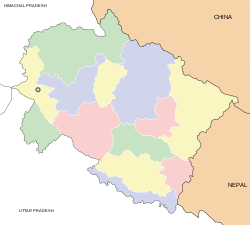Nanda Devi
Nanda Devi (Hindi: नन्दा देवी) is the second highest mountain in India after Kangchenjunga and the highest located entirely within the country. (Kangchenjunga, which is higher, is on the border of India and Nepal.) It is the 23rd-highest peak in the world. It was considered the highest mountain in the world before computations in 1808 proved Dhaulagiri to be higher. It was also the highest mountain in India until 1975 when Sikkim, the state in which Kangchenjunga is located, joined the Republic of India. It is part of the Garhwal Himalayas, and is located in Chamoli district of Uttarakhand, between the Rishiganga valley on the west and the Goriganga valley on the east. The peak, whose name means "Bliss-Giving Goddess",[4] is regarded as the patron-goddess of the Uttarakhand Himalaya. In acknowledgment of its religious significance and for the protection of its fragile ecosystem, the peak as well as the circle of high mountains surrounding it—the Nanda Devi sanctuary—were closed to both locals and climbers in 1983. The surrounding Nanda Devi National Park was declared a UNESCO World Heritage Site in 1988.
| Nanda Devi | |
|---|---|
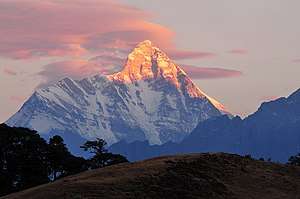 | |
| Highest point | |
| Elevation | 7,816 m (25,643 ft) [1] Ranked 23rd |
| Prominence | 3,139 m (10,299 ft) [1] Ranked 74th |
| Isolation | 389 km (242 mi) |
| Listing | Ultra List of Indian states and territories by highest point |
| Coordinates | 30°22′33″N 79°58′15″E [1][2] |
| Naming | |
| Native name | नन्दा देवी |
| Geography | |
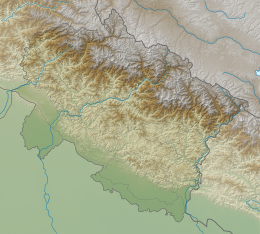 Nanda Devi Location in India  Nanda Devi Nanda Devi (India) | |
| Location | Chamoli, Uttarakhand, India |
| Parent range | Garhwal Himalayas |
| Climbing | |
| First ascent | 29 August 1936 by Noel Odell and Bill Tilman[3][4] |
| Easiest route | south ridge: technical rock/snow/ice climb |
Description and notable features
Nanda Devi is a two-peaked massif, forming a 2-kilometre-long (1.2 mi) high ridge, oriented east-west. The western summit is higher, and the eastern summit, called Nanda Devi East, (locally known as Sunanda Devi) is the lower one. The main summit stands guarded by a barrier ring comprising some of the highest mountains in the Indian Himalayas, twelve of which exceed 6,400 metres (21,000 ft) in height, further elevating its sacred status as the daughter of the Himalaya in Indian myth and folklore. The interior of this almost insurmountable ring is known as the Nanda Devi Sanctuary, and is protected as the Nanda Devi National Park. Nanda Devi East lies on the eastern edge of the ring (and of the Park), at the border of Chamoli, Pithoragarh and Bageshwar districts.
Together the peaks may be referred to as the peaks of the goddesses Nanda and Sunanda. These goddesses have occurred together in ancient Sanskrit literature (Srimad Bhagvatam or Bhagavata Purana) and are worshipped together as twins in the Kumaon, Garhwal and as well as elsewhere in India. The first published reference to Nanda Devi East as Sunanda Devi appears to be in a recent novel (Malhotra 2011) that has the Kumaon region as backdrop.
In addition to being the 23rd highest independent peak in the world, Nanda Devi is also notable for its large, steep rise above local terrain. It rises over 3,300 metres (10,800 ft) above its immediate southwestern base on the Dakkhini Nanda Devi Glacier in about 4.2 kilometres (2.6 mi), and its rise above the glaciers to the north is similar. This makes it among the steepest peaks in the world at this scale, closely comparable, for example, to the local profile of K2. Nanda Devi is also impressive when considering terrain that is a bit further away, as it is surrounded by relatively deep valleys. For example, it rises over 6,500 metres (21,300 ft) above the valley of the Goriganga in only 50 km (30 mi).[5]
On the northern side of the massif lies the Uttari Nanda Devi Glacier, flowing into the Uttari Rishi Glacier. To the southwest, one finds the Dakkhini Nanda Devi Glacier, flowing into the Dakkhini Rishi Glacier. All of these glaciers are located within the Sanctuary, and drain west into the Rishiganga. To the east lies the Pachu Glacier, and to the southeast lie the Nandaghunti and Lawan Glaciers, feeding the Lawan Gad; all of these drain into the Milam Valley. To the south is the Pindari Glacier, draining into the Pindar River. Just to the south of Sunanda Devi, dividing the Lawan Gad drainage from the Dakkhini Nanda Devi Glacier, is Longstaff Col, 5,910 m (19,390 ft), one of the high passes that guard access to the Nanda Devi Sanctuary.[5] For a list of notable peaks of the Sanctuary and its environs, see Nanda Devi National Park.
Exploration and climbing history
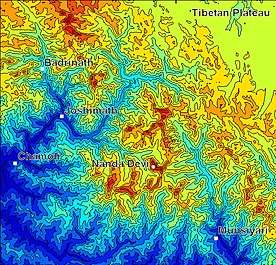
The ascent of Nanda Devi necessitated fifty years of arduous exploration in search of a passage into the Sanctuary. The outlet is the Rishi Gorge, a deep, narrow canyon which is very difficult to traverse safely, and is the biggest hindrance to entering the Sanctuary; any other route involves difficult passes, the lowest of which is 5,180 m (16,990 ft). Hugh Ruttledge attempted to reach the peak three times in the 1930s and failed each time. In a letter to The Times he wrote that 'Nanda Devi imposes on her votaries an admission test as yet beyond their skill and endurance', adding that gaining entry to the Nanda Devi Sanctuary alone was more difficult than reaching the North Pole. In 1934, the British explorers Eric Shipton and H. W. Tilman, with three Sherpa companions, Angtharkay, Pasang and Kusang, finally discovered a way through the Rishi Gorge into the Sanctuary.
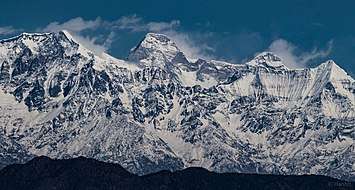
When the mountain was later climbed in 1936 by a British-American expedition, it became the highest peak climbed by man until the 1950 ascent of Annapurna, 8,091 metres (26,545 ft). (However, higher non-summit elevations had already been reached by the British on Mount Everest in the 1920s, and it is possible that George Mallory reached Everest's summit in 1924.) It also involved steeper and more sustained terrain than had been previously attempted at such a high altitude.[4] The expedition climbed the south ridge, also known as the Coxcomb Ridge, which leads relatively directly to the main summit.[3] The summit pair were H. W. Tilman and Noel Odell; Charles Houston was to be in place of Tilman, but he contracted severe food poisoning. Noted mountaineer and mountain writer H. Adams Carter was also on the expedition, which was notable for its small scale and lightweight ethic: it included only seven climbers, and used no fixed ropes, nor any Sherpa support above 6,200 m (20,300 ft). Eric Shipton, who was not involved in the climb itself, called it "the finest mountaineering achievement ever performed in the Himalaya."[4]
After abortive attempts by Indian expeditions in 1957 and 1961, the second ascent of Nanda Devi was accomplished by an Indian team led by N. Kumar in 1964, following the Coxcomb route.
CIA mission
From 1965 to 1968, attempts were made by the Central Intelligence Agency (CIA), in co-operation with the Intelligence Bureau (IB), to place a nuclear-powered telemetry relay listening device on the summit of Nanda Devi. This device was designed to intercept telemetry signals from missile test launches conducted in the Xinjiang Province, at a time of relative infancy in China's missile program.[6] The expedition retreated due to dangerous weather conditions, leaving the device near the summit of Nanda Devi. They returned the next spring to search for the device, which ended without success. As a result of this activity by the CIA, the Sanctuary was closed to foreign expeditions throughout much of the 1960s. In 1974 the Sanctuary re-opened.
Subsequent climbs
A difficult new route, the northwest buttress, was climbed by a 13-person team in 1976. Three Americans, John Roskelley, Jim States and Louis Reichardt, summitted on 1 September. The expedition was co-led by Reichardt, H. Adams Carter (who was on the 1936 climb,) and Willi Unsoeld, who climbed the West Ridge of Everest in 1963. Unsoeld's daughter, Nanda Devi Unsoeld, who was named after the peak, died on this expedition.[7][8] She had been suffering from "diarrhea and flare-up of an inguinal hernia, which had shown up originally on the second day of the approach march", and had been at 7,200 metres (23,600 ft) for nearly five days.[9]
In 1980, the Indian Army Corps of Engineers made an unsuccessful attempt.
This was followed in 1981 by another Indian Army expedition of the Parachute Regiment, which attempted both main and eastern peaks simultaneously. The expedition had placed a memorial to Nanda Devi Unsoeld at the high altitude meadow of Sarson Patal prior to the attempt. The successful attempt lost all its summiteers.
In 1993, a 40-member team of the Indian Army from the Corps of Engineers was given special permission. The aim of the expedition was multifold – to carry out an ecological survey, clean up the garbage left by previous expeditions, and attempt the summit. The team included a number of wildlife scientists and ecologists from Wildlife Institute of India, Salim Ali Centre for Ornithology and Natural History, World Wide Fund for Nature and Govind Ballabh Pant Institute for Himalayan Environment and Development amongst others. The expedition carried out a comprehensive ecological survey and removed from the park, by porter and helicopter, over 1000 kilograms of garbage. Additionally, five summiteers scaled the summit: Amin Nayak, Anand Swaroop, G. K. Sharma, Didar Singh, and S. P. Bhatt.[10]
Recent history and conservation
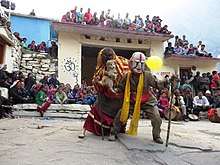
After the re-opening of the sanctuary in 1974 to foreign climbers, trekkers, and locals, the fragile ecosystem was soon compromised by firewood cutting, garbage, and grazing. Serious environmental problems were noted as early as 1977, and the sanctuary was closed again in 1983.[3] Currently, Nanda Devi forms the core of the Nanda Devi Biosphere Reserve (which includes Nanda Devi National Park), declared by the Indian government in 1982. In 1988, Nanda Devi National Park was declared a UNESCO World Heritage Site, "of outstanding cultural or natural importance to the common heritage of humankind."[11] The entire sanctuary, and hence the main summit (and interior approaches to the nearby peaks), are off-limits to locals and to climbing expeditions, though a one-time exception was made in 1993 for a 40-member team from the Indian Army Corps of Engineers to check the state of recovery and to remove garbage left by prior expeditions.[10] Sunanda Devi remains open from the east side, leading to the standard south ridge route. After a sustained campaign by the local community as reflected in the Nanda Devi Declaration[12] of 2001, the core zone of the Nanda Devi was opened for limited eco tourism activity in 2003. In 2006, the campaign invited women trekkers from 4 countries during the inaugural trek inside the National Park. As a follow up, the Campaign for Cultural Survival and Sustainable Livelihoods has now designed an Interpretive Trek to the Nanda Devi National Park.[13] An Interpretation Center on Bio Cultural Diversity of the Nanda Devi National Park is under development in the village of Lata, the gateway to the Nanda Devi National Park. A maximum number of 500/season trekkers are now allowed to enter the core zone till Dharansi between the months of May to October. The trek to Nanda Devi National Park starts from the village of Lata, located 25 kilometers upstream from the town of Joshimath on Niti-Malari highway
References
- "High Asia I: The Karakoram, Pakistan Himalaya and India Himalaya (north of Nepal)". Peaklist.org. Retrieved 28 May 2014.
- The Himalayan Index gives the coordinates of Nanda Devi as 30°22′12″N 79°58′12″E.
- Harish Kapadia, "Nanda Devi", in World Mountaineering, Audrey Salkeld, editor, Bulfinch Press, 1998, ISBN 0-8212-2502-2, pp. 254–257.
- Andy Fanshawe and Stephen Venables, Himalaya Alpine-Style, Hodder and Stoughton, 1995, ISBN 0-340-64931-3.
- Garhwal-Himalaya-Ost, 1:150,000 scale topographic map, prepared in 1992 by Ernst Huber for the Swiss Foundation for Alpine Research, based on maps of the Survey of India.
- Jose, Vinod K. (1 December 2010). "River Deep Mountain High". Caravan Magazine. Retrieved 20 May 2013.
- J. Roskelley, Nanda Devi: The Tragic Expedition (The Mountaineers Books, 2000) ISBN 0-89886-739-8
- American Alpine Journal, 1977.
- Unsoeld, Willie (1977). "Darkness at Noon: The life and death of Nanda Devi Unsoeld". THE AMERICAN ALPINE JOURNAL.
- Sanan, Deepak (1995) Nandadevi – Restoring Glory Sapper Adventure Foundation & Wiley Eastern Limited ISBN 81-224-0752-8
- Nanda Devi and Valley of Flowers National Parks – UNESCO World Heritage Centre
- "Nanda Devi Bio Diversity Conservation and Ecotourism Declaration" (PDF). icimod.org/. 14 October 2001. Retrieved 22 December 2018.
- Misra, Neelesh (15 September 2006). "Nanda Devi opens door". Hindustan Times. Retrieved 22 December 2018.
Books
- Aitken, Bill. (reprinted 1994). The Nanda Devi Affair, Penguin Books India. ISBN 0-14-024045-4.
- Kohli, M.S. & Conboy, K. (2003). Spies in the Himalayas: Secret Missions and Perilous Climbs, University Press of Kansas. ISBN 0-7006-1223-8.
- Jose, Vinod (2010). River Deep, Mountain High, The Caravan Magazine.
- Malhotra, Ashok (2011) Nude Besides the Lake, Createspace ISBN 978-1463529390
- Roskelley, John. (2000). Nanda Devi: The Tragic Expedition, The Mountaineers Books. ISBN 0-89886-739-8 .
- Sanan, Deepak. (1995) Nandadevi – Restoring Glory – New Age International (Wiley Eastern Ltd), New Delhi. ISBN 81-224-0752-8.
- Shipton, E., Tilman, H.W. & Houston, C. (Reprinted 2000). Nanda Devi:Exploration and Ascent, The Mountaineers Books. ISBN 0-89886-721-5.
- Sircar, J. (1979) Himalayan Handbook, (private pub., Calcutta).
- Takeda, Peter. (2006) An Eye at the Top of the World: The Terrifying Legacy of the Cold War's Most Daring C.I.A. Operation, Thunder's Mouth Press. ISBN 1-56025-845-4.
- Thomson, Hugh (2004) Nanda Devi: A Journey to the Last Sanctuary, Weidenfeld & Nicolson ISBN 0-297-60753-7
- Tilman, H. W., The Ascent of Nanda Devi, Cambridge University Press. 1937.
External links
| Wikimedia Commons has media related to Nanda Devi. |
- "Kargil war hero missing in Nanda Devi snowstorm" Indianexpress.com
- Nanda Devi Campaign – web site of the local inhabitants
- "Nanda Devi". Peakware.com. Archived from the original on 4 March 2016. – photos
- Unesco World Heritage Site on Nanda Devi
- GMVN – Uttarakhand Tourism page on Nanda Devi National Park
- 'High heaven: a trek to the top of the world' The Independent- article describing the Nanda Devi Sanctuary
